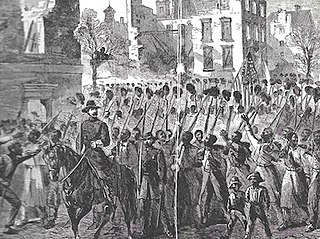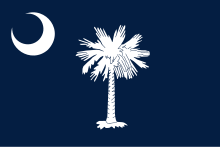
The 54th Massachusetts Infantry Regiment was an infantry regiment that saw extensive service in the Union Army during the American Civil War. The unit was the second African-American regiment, following the 1st Kansas Colored Volunteer Infantry Regiment, organized in the Northern states during the Civil War. Authorized by the Emancipation Proclamation, the regiment consisted of African-American enlisted men commanded by white officers. The 54th Massachusetts was a major force in the pioneering of African American civil war regiments, with 150 all black regiments being raised after the raising of the 54th Massachusetts.

United States Colored Troops (USCT) were Union Army regiments during the American Civil War that primarily comprised African Americans, with soldiers from other ethnic groups also serving in USCT units. Established in response to a demand for more units from Union Army commanders, USCT regiments, which numbered 175 in total by the end of the war in 1865, constituted about one-tenth of the manpower of the army, according to historian Kelly Mezurek, author of For Their Own Cause: The 27th United States Colored Troops. "They served in infantry, artillery, and cavalry." Approximately 20 percent of USCT soldiers were killed in action or died of disease and other causes, a rate about 35 percent higher than that of white Union troops. Numerous USCT soldiers fought with distinction, with 16 receiving the Medal of Honor. The USCT regiments were precursors to the Buffalo Soldier units which fought in the American Indian Wars.

The African American Civil War Memorial Museum, in the U Street district of Washington, D.C., recognizes the contributions of the 209,145 members of the United States Colored Troops (USCT). The eponymous memorial, dedicated in July 1998 by the African American Civil War Memorial Freedom Foundation, commemorates the service of 209,145 African-American soldiers and about 7,000 white and 2,145 Hispanic soldiers, together with the approximate 20,000 unsegregated Navy sailors, who fought for the Union in the American Civil War, mostly among the 175 regiments of United States Colored Troops.
Fort Howell is an earthworks fort built in 1864 during the American Civil War, located on Hilton Head Island, South Carolina. It was named in honor of Union Army Brigadier General Joshua B. Howell, and Its primary function was to protect Mitchelville, a Freedman's town located to its east.

The 1st South Carolina Volunteer Infantry Regiment (Colored) was a Union Army regiment during the American Civil War, formed by General Rufus Saxton. It was composed of Gullah Geechee recruits and escaped slaves from South Carolina, Georgia, and Florida. The 1st SC Volunteer Infantry black regiment was formed in 1862 and became the 33rd United States Colored Troops Regiment in February of 1864. It has the distinction of being the first black regiment to fight in the Civil War at the Skirmish at Spaulding's on the Sapelo River GA. It was one of the first black regiments in the Union Army.

James H. Harris was a Union Army soldier during the American Civil War. He earned the highest military decoration in the United States—the Medal of Honor—for his actions at the Battle of Chaffin's Farm. He was African American.

Thomas R. Hawkins was an African-American Union Army soldier during the American Civil War and a recipient of America's highest military decoration—the Medal of Honor—for his actions at the Battle of Chaffin's Farm.

Alfred B. Hilton was an African American Union Army soldier during the American Civil War and a recipient of America's highest military decoration—the Medal of Honor—for his actions at the Battle of Chaffin's Farm.

Charles Veale or Veal was an African American Union Army soldier during the American Civil War and a recipient of America's highest military decoration—the Medal of Honor—for his actions at the Battle of Chaffin's Farm.

George VanStavoren Kelley was a line officer in the Union Army during the American Civil War. He received the Medal of Honor for gallantry at the Battle of Franklin during the 1864 Franklin-Nashville Campaign.
The 62nd Ohio Infantry Regiment was an infantry regiment in the Union Army during the American Civil War.
The 67th Ohio Infantry Regiment was an infantry regiment in the Union Army during the American Civil War.
The 7th United States Colored Infantry was an infantry regiment that served in the Union Army during the American Civil War. The regiment was composed of African American enlisted men commanded by white officers and was authorized by the Bureau of Colored Troops which was created by the United States War Department on May 22, 1863.
The 8th United States Colored Infantry was an infantry regiment that served in the Union Army during the American Civil War. The regiment was composed of African American enlisted men commanded by white officers and was authorized by the Bureau of Colored Troops which was created by the United States War Department on May 22, 1863.
The 9th United States Colored Infantry was an infantry regiment that served in the Union Army during the American Civil War. The regiment was composed of African American enlisted men commanded by white officers and was authorized by the Bureau of Colored Troops which was created by the United States War Department on May 22, 1863.

The 55th Massachusetts Infantry Regiment was the sister regiment of the renowned Massachusetts 54th Volunteers during the latter half of the American Civil War. The enactment of the Emancipation Proclamation by United States President Abraham Lincoln on January 1, 1863 opened the way for the enlistment of free men of color and newly liberated slaves to fight for their freedom within the Union Army. As the ranks of the 54th Massachusetts quickly reached its full complement of recruits, an overflow of colored volunteers continued to pour in from several other states outside Massachusetts — many of whom simply had not arrived in time — prompting Governor John Albion Andrew to authorize yet another regiment of colored soldiers sponsored by the Commonwealth. Lieutenant Colonel Norwood P. Hallowell of the 54th Massachusetts was promoted to colonel and appointed commander of the 55th Massachusetts on May 30, 1863. Five companies of the 55th Massachusetts were mustered into service on May 31; two more companies were mustered in on June 15; and the last three on June 22.
The 32nd United States Colored Infantry was an infantry regiment that served in the Union Army during the American Civil War. The regiment was composed of African American enlisted men commanded by white officers and was authorized by the Bureau of Colored Troops which was created by the United States War Department on May 22, 1863.
The 35th United States Colored Infantry was an infantry regiment that served in the Union Army during the American Civil War. The regiment was composed of African American enlisted men commanded by white officers and was authorized by the Bureau of Colored Troops which was created by the United States War Department on May 22, 1863.
The 44th United States Colored Infantry was an infantry regiment that served in the Union Army during the American Civil War. The regiment was composed of African American enlisted men commanded by white officers and was authorized by the Bureau of Colored Troops which was created by the United States War Department on May 22, 1863.
Augustus Griffin Bennett was an American soldier who was a commanding officer in the Union Army during the American Civil War. He led "colored" soldiers in the 3rd South Carolina Volunteer Infantry Regiment (Colored). He took control of Charleston, South Carolina after rebels departed.









